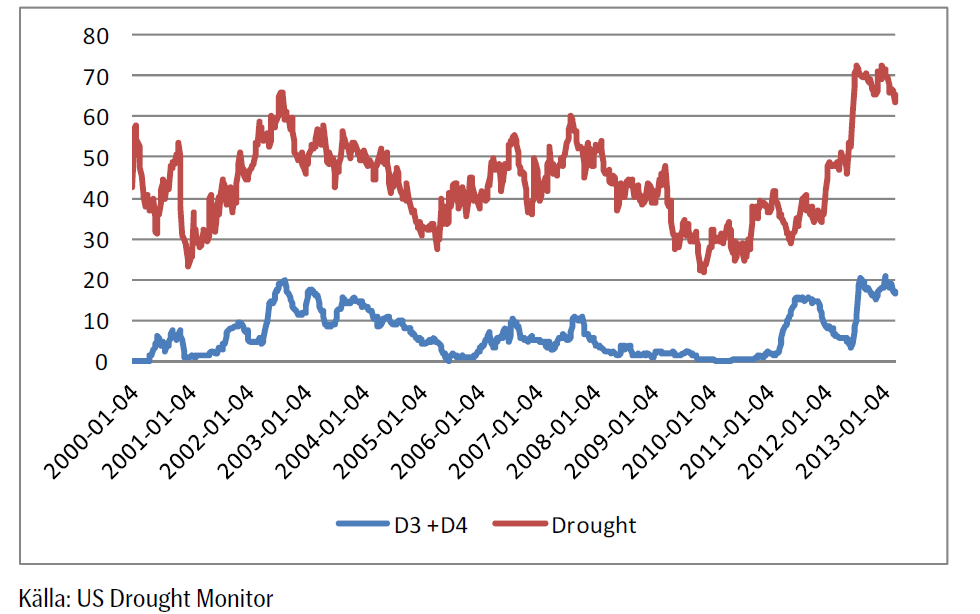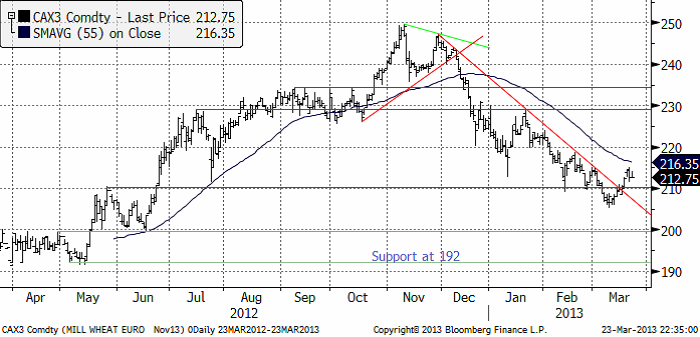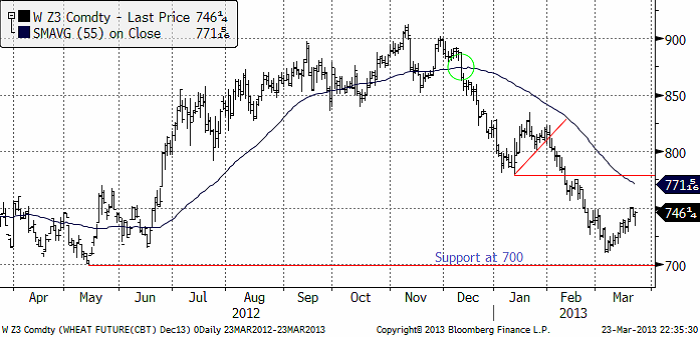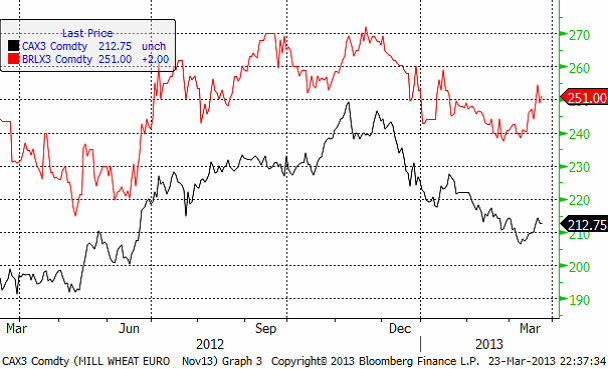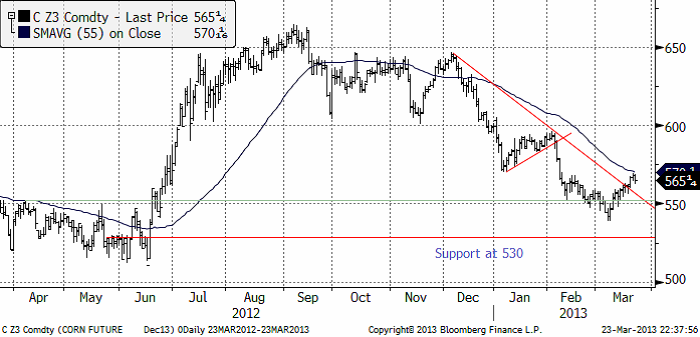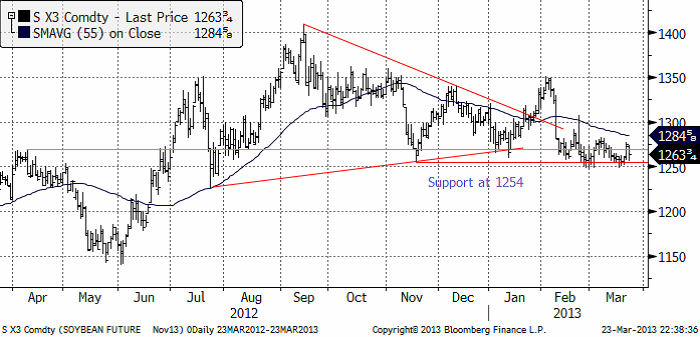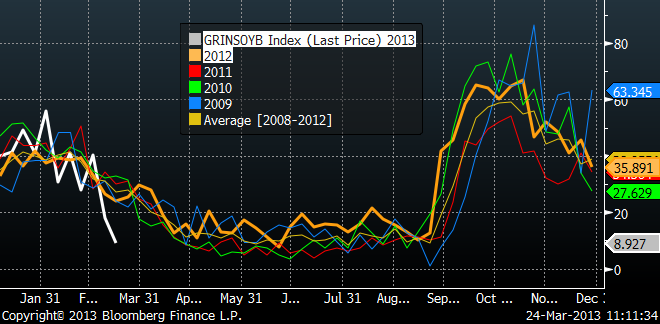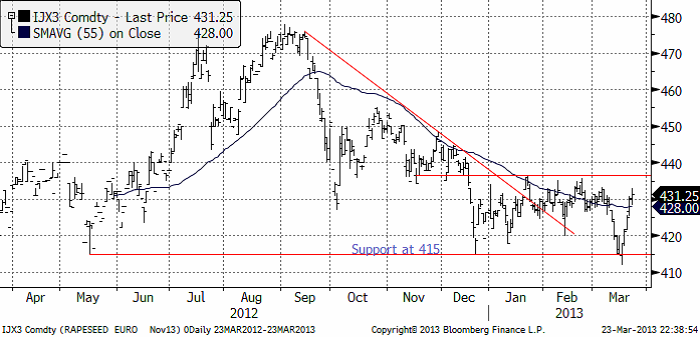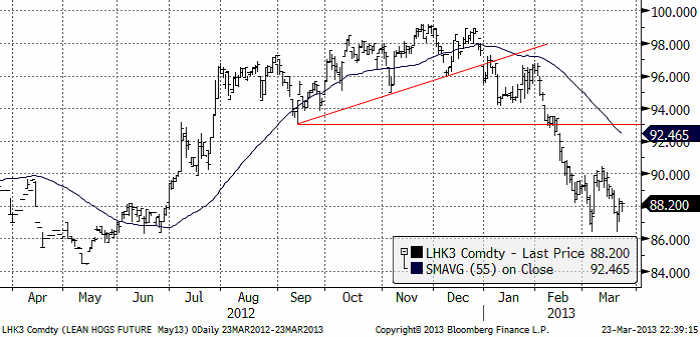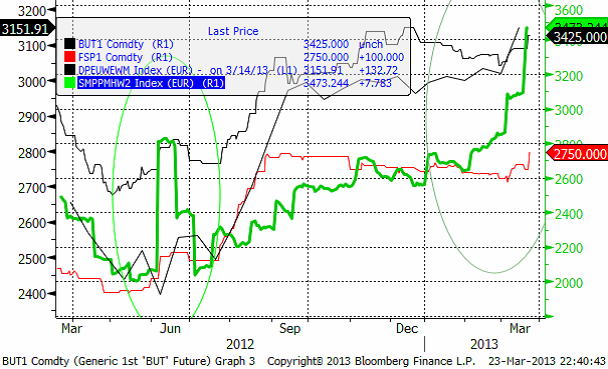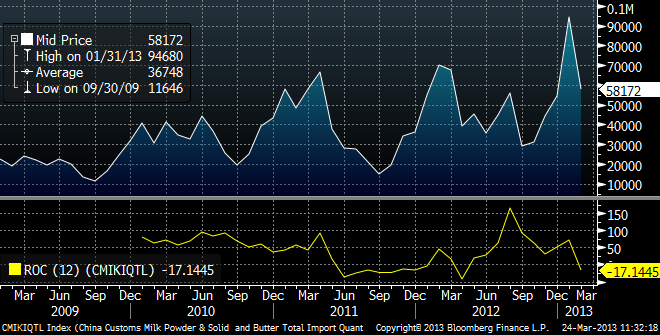Analys
SEB Jordbruksprodukter, 25 mars 2013
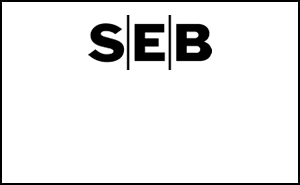
 Förra veckans handel i jordbruksprodukterna påverkades endast ytligt av svallvågorna från Cypernkrisen. Priserna steg överlag på nästan alla marknader. Starkast gick vete. Jag tror att det huvudsakligen handlar om att priset fallit lite för långt ner på allt för tidigt inkasserade förhoppningar om regn i USA. Torkan i USA registrerades som något värre förra veckan än veckan innan. Europa oroar sig förvånande lite över de extremt låga utgående lager som t ex USDA har för EU-27. Lagerstatistiken som USDA publicerar på torsdag den 28 mars kan skapa en hel del volatilitet. Klockan 17 presenteras uppdaterade siffror på ”prospective plantings” för vete och majs och lagerstatistiken per den första mars.
Förra veckans handel i jordbruksprodukterna påverkades endast ytligt av svallvågorna från Cypernkrisen. Priserna steg överlag på nästan alla marknader. Starkast gick vete. Jag tror att det huvudsakligen handlar om att priset fallit lite för långt ner på allt för tidigt inkasserade förhoppningar om regn i USA. Torkan i USA registrerades som något värre förra veckan än veckan innan. Europa oroar sig förvånande lite över de extremt låga utgående lager som t ex USDA har för EU-27. Lagerstatistiken som USDA publicerar på torsdag den 28 mars kan skapa en hel del volatilitet. Klockan 17 presenteras uppdaterade siffror på ”prospective plantings” för vete och majs och lagerstatistiken per den första mars.
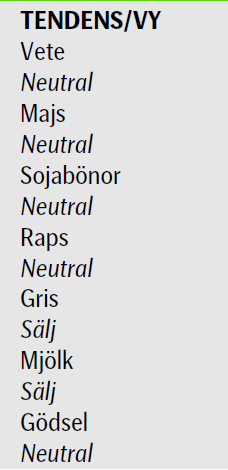 Veckans Fonterra-auktion visade priser som återigen ligger rejält mycket högre än förra auktionen. Priserna på Eurex reagerade med att stiga lite grand. Pressen försöker i vanlig ordning hitta på en ”story” bakom prisuppgången. Bland annat nämns torkan i Nya Zealand (som egentligen till stor del är historia) och kinas glupande aptit på SMP (som också hör till förra året). Februaris import jämfört med samma månad förra året visar på en 17%-ig minskning).
Veckans Fonterra-auktion visade priser som återigen ligger rejält mycket högre än förra auktionen. Priserna på Eurex reagerade med att stiga lite grand. Pressen försöker i vanlig ordning hitta på en ”story” bakom prisuppgången. Bland annat nämns torkan i Nya Zealand (som egentligen till stor del är historia) och kinas glupande aptit på SMP (som också hör till förra året). Februaris import jämfört med samma månad förra året visar på en 17%-ig minskning).
Fram till torsdag väntar vi oss inte några stora kursrörelser. Folk kommer att trimma sina positioner för att inte drabbas av slumpen när lagerstatistiken publiceras på torsdag. Oron är att lagren ska visa sig mindre än väntat. Så har det varit 8 av 10 gånger de senaste åren. Det innebär i sig att risk/reward talar för en prisnedgång på rapportsiffrorna, allt annat lika.
Odlingsväder
US Drought Monitor visar återigen mer av USA drabbat av torka. Den 19 mars var 65% av ytan drabbad av torka. Veckan innan var det 63.7%. Extrem och exceptionell torka ökade till 16.85% av ytan från 16.51% för två veckor sedan.
Marknaden har diskonterat att trenden har vänt till våtare väder, men detta är kanske att ropa ”hej” lite för tidigt. Kanske ligger denna tvekan om torkans nära förestående slut bakom veckans prisuppgång på spannmål.
Hela Europa har varit kallt och torrt. Det har varit kallt och torrt även i USA och i Kanada.
I Brasilien är det varmt och med mycket regn.
Vete
Priset på november (2013) rekylerade som väntat uppåt. 210 Euro bröts och även trendlinjen, motståndet för prisnedgången sedan i början av december. Detta bekräftar tekniskt att prisnedgången är över. Jag tror inte att vi kommer att få se en förlängning av den rekyl uppåt vi sett de senaste dagarna. Det är säkerligen många lantbrukare som passar på att prissäkra nu – i vart fall borde de göra det. Sidledes prisrörelse är mer trolig den närmaste tiden. Det vill säga, en liten prisnedgång i veckan som kommer, kanske ner mot 210 igen.
Decemberkontraktet på CBOT har stigit relativt brant. Sättet som det har skett stämmer väl överens med hur rekyler mot trenden brukar se ut. Det finns säkerligen många lantbrukare som hängt upp sig på 750 cent. Den här marknaden kommer att ha väldigt svårt att gå över den nivån om det inte kommer nya rapporter om väder och skörd som stör.
På torsdag kommer som bekant lagerstatistiken per 1 mars i USA. Det brukar vara stor volatilitet när dessa siffror kommer.
Maltkorn
Maltkorn (november 2013) har fortsatt att utveckla sig starkare än kvarnvetet. Prisskillnaden mellan maltkorn och kvarnvete har vidgats nu i mars. Om man kan, kan det vara en god idé att försöka prissäkra maltkorn i maltkornskontraktet, snare än kvarnvetekontraktet, även om maltkornskontraktet är betydligt mer illikvitt. Man kan lägga limiterade säljordrar.
Majs
Majspriset (december 2013) har liksom vetet brutit den fallande trendlinjen. Detta signalerar att prisfallet är över. Liksom för vetet tycker jag däremot inte att man ska ge sig in och köpa majs. Det finns alldeles för mycket osäkerhet i väder, med mera.
Vi har samma tolkning av marknaden som förra veckan. Prisfallet har troligtvis ebbat ut och priset bör röra sig ”sidledes”. Lagerstatistiken på torsdag kan ändra det.
Sojabönor
Sojabönorna (november 2013) testar ideligen stödet på 1250 cent / bushel.
Gammal amerikansk skörd tycks vara mer eller mindre slut. Export inspections halverades i veckan som gick. Takten på exporten och på inhemsk efterfrågan från ”crushers” har legat på en ohållbart hög nivå. Det var därför egentligen en tidsfråga innan exporten – och ”crushen” skulle ta minska. Bönorna håller helt enkelt på att ta slut.
I diagrammet nedan ser vi export inspections för olika kalenderår. Vit kurva är 2013 och orange kurva är 2012. Slutet av 2012 års kurva är 2012/13 års skörd och vit kurva är förstås det också. Vi ser att exporten kom igång förhållandevis tidigt i höstas och att exporten nu tagit slut rekordtidigt.
Skörden i Brasilien ligger lite efter det normala. I början av mars hade 60% skördats. I Mato Grosso är ca 80% klart, men i Santa Catarina och Rio Grande do Sul nere i södra delen av landet är bara 12% klart, enligt CEPEA.
Eftersom det regnar så mycket kring Mato Grosso har man stora problem med vägarna. Det är svårt att få ut produkten till hamnarna. Detta förklarar till viss del att USA fått exportera så mycket och hållit priset uppe på CBOT.
Marknadsläget är oförändrat från förra veckan: I veckan som kommer får man hålla koll på om priset håller sig över det tekniska stödet vid 1254 eller om det bryts. Om det bryts vill vi vara korta sojabönor.
Raps
Rapspriset (november 2013) som i torsdags för en dryg vecka sedan föll rakt ner till stödet på 415 euro, tvärvände och gick rakt upp förra veckan. Nu ligger priset återigen i den övre delen av det prisintervall mellan 415 och 437 euro som priset har legat inom sedan december.
Gris
Grispriset (Maj 13) tycks ha stabiliserat sig efter det stora prisfallet som varit. Frågan är om detta kan utveckla sig till en botten, som priset kan finna ny styrka från.
Mjölk
Tisdagens Fonterra-auktion var visade återigen kraftigt högre priser på SMP. Auktionen åtföljdes i pressen av nyhetsartiklar om den svåra torkan i Nya Zeeland och Kinas växande import av mjölkpulver.
I kursdiagrammet nedan ser vi fyra kurvor, som förra veckan. Överst har vi smör i euro per ton, alla är i euro per ton. Den tunna linjen USDA:s notering för SMP i västra Europa. Den feta röda linjen är terminspriset på SMP på Eurex, som avser snittpriset på SMP i Tyskland, Holland och Frankrike. Den gröna linjen är Fonterras auktionspris på SMP.
Fonterra-priserna har stigit kraftigt i två månader nu och det har fått priserna på Eurex att reagera. Förra veckan var egentligen första gången som Eurex / den europeiska marknaden tog notis om vad som händer på Fonterra-auktionerna. USDA:s index för helmjölkspulver FOB Västeuropa steg också i förra veckans notering.
När det gäller torkan i Nya Zeeland så har det varit torrt framförallt på den norra ön i februari. Mars har lite mindre nederbörd än normalt. I skrivande stund regnar det på den södra ön.
När det gäller Kinas import, ser vi månadsvis statistik nedan. Den senaste noteringen är från februari, som var en månad med mycket ledighet och därmed lägre importaktivitet. I den nedre delen av diagrammet finns en kurva som visar årsvis förändring. Februaris import låg alltså 17% lägre än den gjorde i februari förra året. Sant är att importen från juni och fram till februari visade en stark ökningstakt, uppemot 100% högre än året innan. Men som vi ser har suget avtagit sedan i somras / höstas.
Prisuppgången på Fonterra-auktionen är lite kraftigare än de ”spikar” vi har sett tidigare. Den börjar få effekt på andra prisindikatorer och på marknadspriset på Eurex. Vi har haft en säljrekommendation och tror alltjämt att priset är ”högt”. Den stora importökningen i Kina ligger i historien. I årstakt är faktiskt importen lägre än den var förra året. Kortsiktigt kan den påfallande kraftiga styrkan i Fonterra-priserna sprida sig till andra marknader, så man kanske ska avvakta någon vecka eller två med att sälja terminer. Långsiktigt har vi säljrekommendation på terminerna, men kortsiktigt neutral.
[box]SEB Veckobrev Jordbruksprodukter är producerat av SEB Merchant Banking och publiceras i samarbete och med tillstånd på Råvarumarknaden.se[/box]
Disclaimer
The information in this document has been compiled by SEB Merchant Banking, a division within Skandinaviska Enskilda Banken AB (publ) (“SEB”).
Opinions contained in this report represent the bank’s present opinion only and are subject to change without notice. All information contained in this report has been compiled in good faith from sources believed to be reliable. However, no representation or warranty, expressed or implied, is made with respect to the completeness or accuracy of its contents and the information is not to be relied upon as authoritative. Anyone considering taking actions based upon the content of this document is urged to base his or her investment decisions upon such investigations as he or she deems necessary. This document is being provided as information only, and no specific actions are being solicited as a result of it; to the extent permitted by law, no liability whatsoever is accepted for any direct or consequential loss arising from use of this document or its contents.
About SEB
SEB is a public company incorporated in Stockholm, Sweden, with limited liability. It is a participant at major Nordic and other European Regulated Markets and Multilateral Trading Facilities (as well as some non-European equivalent markets) for trading in financial instruments, such as markets operated by NASDAQ OMX, NYSE Euronext, London Stock Exchange, Deutsche Börse, Swiss Exchanges, Turquoise and Chi-X. SEB is authorized and regulated by Finansinspektionen in Sweden; it is authorized and subject to limited regulation by the Financial Services Authority for the conduct of designated investment business in the UK, and is subject to the provisions of relevant regulators in all other jurisdictions where SEB conducts operations. SEB Merchant Banking. All rights reserved.
Analys
Brent crude ticks higher on tension, but market structure stays soft

Brent crude has climbed roughly USD 1.5-2 per barrel since Friday, yet falling USD 0.3 per barrel this mornig and currently trading near USD 67.25/bbl after yesterday’s climb. While the rally reflects short-term geopolitical tension, price action has been choppy, and crude remains locked in a broader range – caught between supply-side pressure and spot resilience.

Prices have been supported by renewed Ukrainian drone strikes targeting Russian infrastructure. Over the weekend, falling debris triggered a fire at the 20mtpa Kirishi refinery, following last week’s attack on the key Primorsk terminal.
Argus estimates that these attacks have halted ish 300 kbl/d of Russian refining capacity in August and September. While the market impact is limited for now, the action signals Kyiv’s growing willingness to disrupt oil flows – supporting a soft geopolitical floor under prices.
The political environment is shifting: the EU is reportedly considering sanctions on Indian and Chinese firms facilitating Russian crude flows, while the U.S. has so far held back – despite Bessent warning that any action from Washington depends on broader European participation. Senator Graham has also publicly criticized NATO members like Slovakia and Hungary for continuing Russian oil imports.
It’s worth noting that China and India remain the two largest buyers of Russian barrels since the invasion of Ukraine. While New Delhi has been hit with 50% secondary tariffs, Beijing has been spared so far.
Still, the broader supply/demand balance leans bearish. Futures markets reflect this: Brent’s prompt spread (gauge of near-term tightness) has narrowed to the current USD 0.42/bl, down from USD 0.96/bl two months ago, pointing to weakening backwardation.
This aligns with expectations for a record surplus in 2026, largely driven by the faster-than-anticipated return of OPEC+ barrels to market. OPEC+ is gathering in Vienna this week to begin revising member production capacity estimates – setting the stage for new output baselines from 2027. The group aims to agree on how to define “maximum sustainable capacity,” with a proposal expected by year-end.
While the IEA pegs OPEC+ capacity at 47.9 million barrels per day, actual output in August was only 42.4 million barrels per day. Disagreements over data and quota fairness (especially from Iraq and Nigeria) have already delayed this process. Angola even quit the group last year after being assigned a lower target than expected. It also remains unclear whether Russia and Iraq can regain earlier output levels due to infrastructure constraints.
Also, macro remains another key driver this week. A 25bp Fed rate cut is widely expected tomorrow (Wednesday), and commodities in general could benefit a potential cut.
Summing up: Brent crude continues to drift sideways, finding near-term support from geopolitics and refining strength. But with surplus building and market structure softening, the upside may remain capped.
Analys
Volatile but going nowhere. Brent crude circles USD 66 as market weighs surplus vs risk

Brent crude is essentially flat on the week, but after a volatile ride. Prices started Monday near USD 65.5/bl, climbed steadily to a mid-week high of USD 67.8/bl on Wednesday evening, before falling sharply – losing about USD 2/bl during Thursday’s session.

Brent is currently trading around USD 65.8/bl, right back where it began. The volatility reflects the market’s ongoing struggle to balance growing surplus risks against persistent geopolitical uncertainty and resilient refined product margins. Thursday’s slide snapped a three-day rally and came largely in response to a string of bearish signals, most notably from the IEA’s updated short-term outlook.
The IEA now projects record global oversupply in 2026, reinforcing concerns flagged earlier by the U.S. EIA, which already sees inventories building this quarter. The forecast comes just days after OPEC+ confirmed it will continue returning idle barrels to the market in October – albeit at a slower pace of +137,000 bl/d. While modest, the move underscores a steady push to reclaim market share and adds to supply-side pressure into year-end.
Thursday’s price drop also followed geopolitical incidences: Israeli airstrikes reportedly targeted Hamas leadership in Doha, while Russian drones crossed into Polish airspace – events that initially sent crude higher as traders covered short positions.
Yet, sentiment remains broadly cautious. Strong refining margins and low inventories at key pricing hubs like Europe continue to support the downside. Chinese stockpiling of discounted Russian barrels and tightness in refined product markets – especially diesel – are also lending support.
On the demand side, the IEA revised up its 2025 global demand growth forecast by 60,000 bl/d to 740,000 bl/d YoY, while leaving 2026 unchanged at 698,000 bl/d. Interestingly, the agency also signaled that its next long-term report could show global oil demand rising through 2050.
Meanwhile, OPEC offered a contrasting view in its latest Monthly Oil Market Report, maintaining expectations for a supply deficit both this year and next, even as its members raise output. The group kept its demand growth estimates for 2025 and 2026 unchanged at 1.29 million bl/d and 1.38 million bl/d, respectively.
We continue to watch whether the bearish supply outlook will outweigh geopolitical risk, and if Brent can continue to find support above USD 65/bl – a level increasingly seen as a soft floor for OPEC+ policy.
Analys
Waiting for the surplus while we worry about Israel and Qatar

Brent crude makes some gains as Israel’s attack on Hamas in Qatar rattles markets. Brent crude spiked to a high of USD 67.38/b yesterday as Israel made a strike on Hamas in Qatar. But it wasn’t able to hold on to that level and only closed up 0.6% in the end at USD 66.39/b. This morning it is starting on the up with a gain of 0.9% at USD 67/b. Still rattled by Israel’s attack on Hamas in Qatar yesterday. Brent is getting some help on the margin this morning with Asian equities higher and copper gaining half a percent. But the dark cloud of surplus ahead is nonetheless hanging over the market with Brent trading two dollar lower than last Tuesday.

Geopolitical risk premiums in oil rarely lasts long unless actual supply disruption kicks in. While Israel’s attack on Hamas in Qatar is shocking, the geopolitical risk lifting crude oil yesterday and this morning is unlikely to last very long as such geopolitical risk premiums usually do not last long unless real disruption kicks in.
US API data yesterday indicated a US crude and product stock build last week of 3.1 mb. The US API last evening released partial US oil inventory data indicating that US crude stocks rose 1.3 mb and middle distillates rose 1.5 mb while gasoline rose 0.3 mb. In total a bit more than 3 mb increase. US crude and product stocks usually rise around 1 mb per week this time of year. So US commercial crude and product stock rose 2 mb over the past week adjusted for the seasonal norm. Official and complete data are due today at 16:30.
A 2 mb/week seasonally adj. US stock build implies a 1 – 1.4 mb/d global surplus if it is persistent. Assume that if the global oil market is running a surplus then some 20% to 30% of that surplus ends up in US commercial inventories. A 2 mb seasonally adjusted inventory build equals 286 kb/d. Divide by 0.2 to 0.3 and we get an implied global surplus of 950 kb/d to 1430 kb/d. A 2 mb/week seasonally adjusted build in US oil inventories is close to noise unless it is a persistent pattern every week.
US IEA STEO oil report: Robust surplus ahead and Brent averaging USD 51/b in 2026. The US EIA yesterday released its monthly STEO oil report. It projected a large and persistent surplus ahead. It estimates a global surplus of 2.2 m/d from September to December this year. A 2.4 mb/d surplus in Q1-26 and an average surplus for 2026 of 1.6 mb/d resulting in an average Brent crude oil price of USD 51/b next year. And that includes an assumption where OPEC crude oil production only averages 27.8 mb/d in 2026 versus 27.0 mb/d in 2024 and 28.6 mb/d in August.
Brent will feel the bear-pressure once US/OECD stocks starts visible build. In the meanwhile the oil market sits waiting for this projected surplus to materialize in US and OECD inventories. Once they visibly starts to build on a consistent basis, then Brent crude will likely quickly lose altitude. And unless some unforeseen supply disruption kicks in, it is bound to happen.
US IEA STEO September report. In total not much different than it was in January
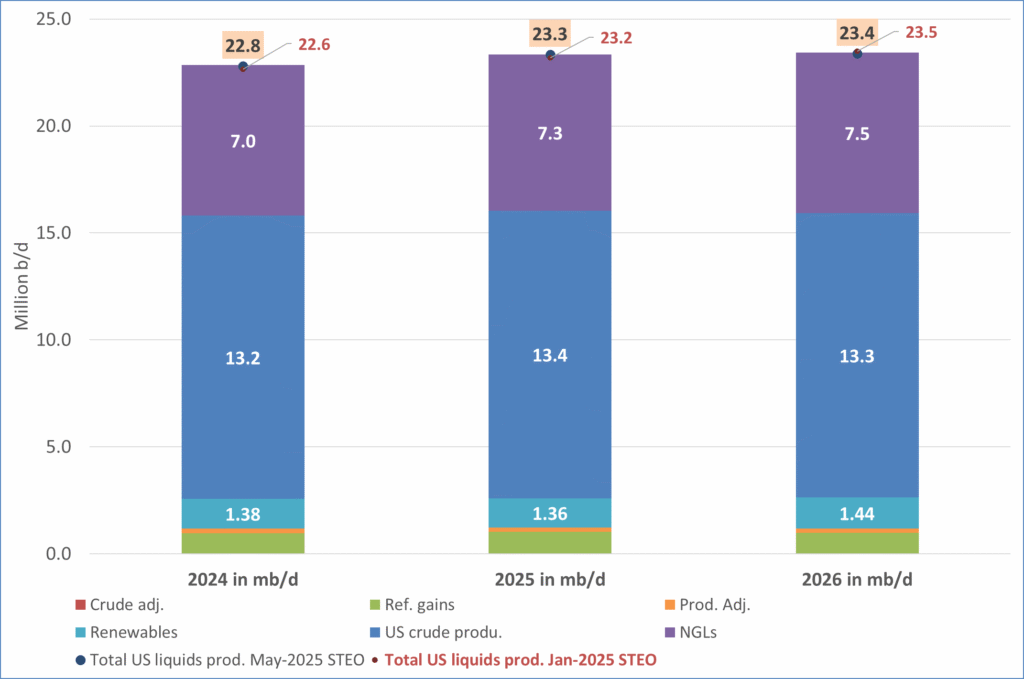
US IEA STEO September report. US crude oil production contracting in 2026, but NGLs still growing. Close to zero net liquids growth in total.
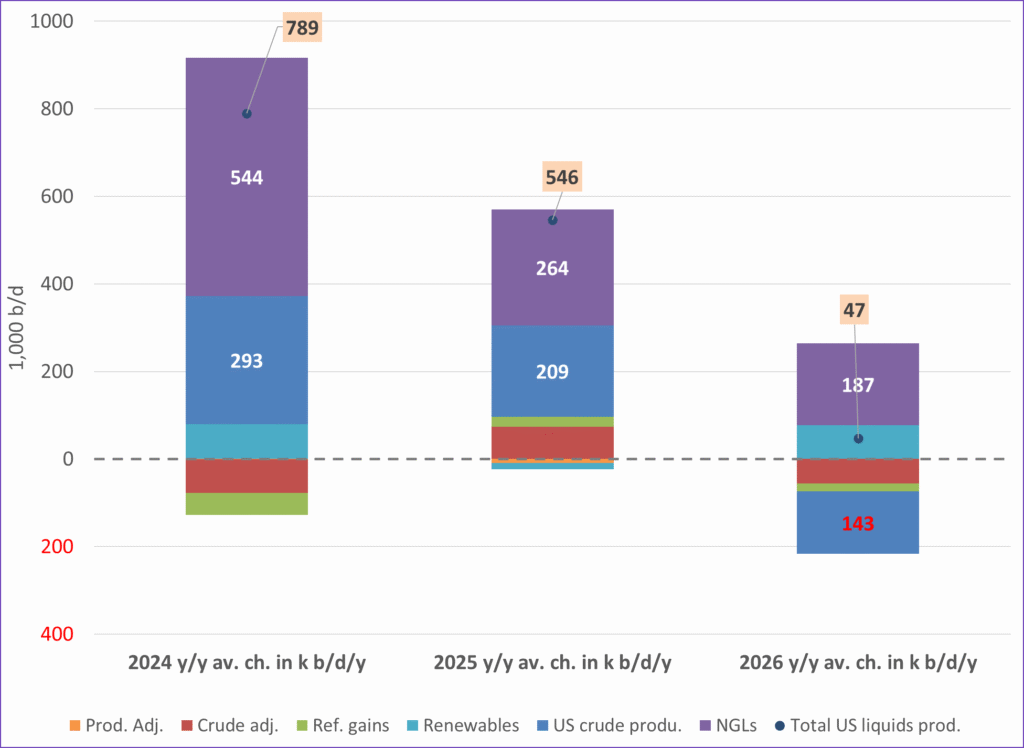
-

 Nyheter4 veckor sedan
Nyheter4 veckor sedanMeta bygger ett AI-datacenter på 5 GW och 2,25 GW gaskraftverk
-
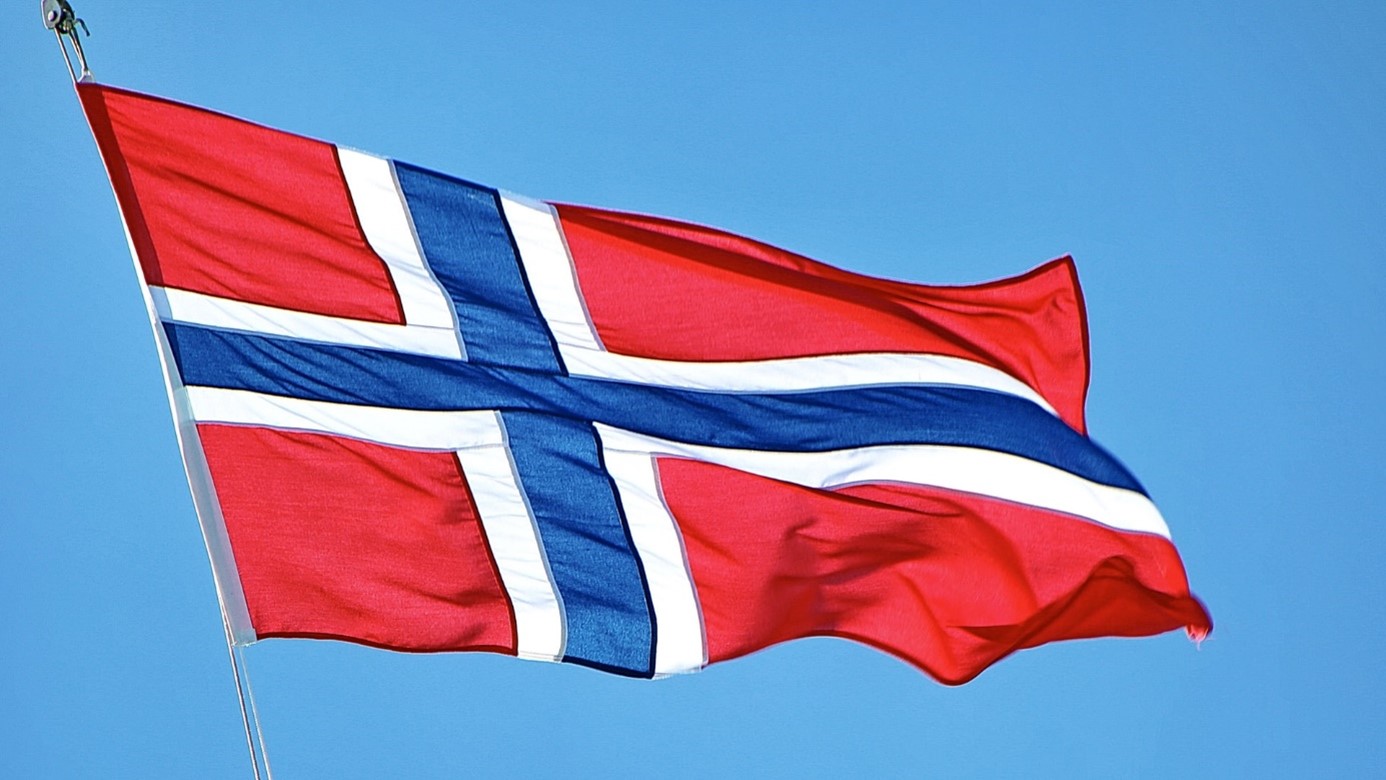
 Nyheter4 veckor sedan
Nyheter4 veckor sedanAker BP gör ett av Norges största oljefynd på ett decennium, stärker resurserna i Yggdrasilområdet
-

 Analys4 veckor sedan
Analys4 veckor sedanBrent sideways on sanctions and peace talks
-

 Nyheter4 veckor sedan
Nyheter4 veckor sedanEtt samtal om koppar, kaffe och spannmål
-

 Nyheter4 veckor sedan
Nyheter4 veckor sedanSommarens torka kan ge högre elpriser i höst
-

 Analys4 veckor sedan
Analys4 veckor sedanBrent edges higher as India–Russia oil trade draws U.S. ire and Powell takes the stage at Jackson Hole
-
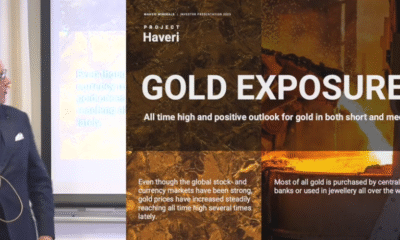
 Nyheter3 veckor sedan
Nyheter3 veckor sedanMahvie Minerals är verksamt i guldrikt område i Finland
-

 Analys3 veckor sedan
Analys3 veckor sedanIncreasing risk that OPEC+ will unwind the last 1.65 mb/d of cuts when they meet on 7 September


